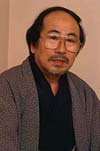
PROFILE SAJIRO TANAKA 1937 Born in Kita Kyushu 1965 Began research into Jomon and Yayoi earthenware 1971 Began excavation survey of Ko-Karatsu- ware and began making pottery 1975 Established a nobori gama (climbing kiln) in Handa, Karatsu-shi 1978 Began the first of yearly nationwide solo exhibition 1980 Began studying under Tokuro Kato 1985 Held exhibition at Shibuya Kuroda Ceramics (which thereafter became a yearly event) 1987 Established waritakeshiki-renbo nobori gama (split bamboo-shaped climbing kiln) in Yamase. First firing was in September of that year. Saga Prefecture, Higashi-Matsuura Gun, Hamatama-cho, Yamase Mari Ishi Telephone 0955-56-8280 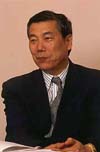
PROFILE KUSAOMI KURODA Born 1943 in Kamakura-shi, Kanagawa Prefecture Graduated from Meiji Gakuen University, Dept. of Economics President of Shibuya Kuroda Ceramics Organized "O-Bizen Exhibition," "Shino and Oribe Exhibition," "Contemporary Ceramic Artists Exhibition" Has written article ("Three Men of Ceramics" and "About Ceramics, Now and in the Past") for the monthly magazine, "Yu-Raku" (Mugen Publishing Company) Published the book, "Tokoton Bizen," from Kogei Shuppan Shibuya Kuroda Ceramics Metroplaza 1F, Shibuya 1-16-14, Shibuya-ku, Tokyo Tel: 03-3499-3225 Shibuya Kuroda Ceramics HOME PAGE http://www.kurodatoen.co.jp |
KUSAOMI Let's begin by telling us why you first became interested in ceramics. SAJIRO I think it basically began with my interest in Jomon and Yayoi ware. Both Jomon and Yayoi ware were, of course, unglazed. Before I established my own kiln at the age of 38, I spent traveled all around Japan. During my twenties, when given the opportunity, I would go to many places to participate in excavations. I studied archaeology and my interest in it grew. A friend invited me to take part in a Karatsu-ware dig which gave me hands-on experience. I am a Kyushu person, and I felt a familiarity with the simplicity of Karatsu-ware. Moreover, I was attracted to the spirits of our ancestors who were carved in the annals of old ceramic making. KUSAOMI How long ago was this? SAJIRO The Ko-Karatsu excavation survey I'm involved in now, I first took up in 1971 when I was 34 years old. When I was about 20 years old, I became rather obsessed with Zen and did zazen during visits to temples. In other words, I became interested in Buddhism. I tried pottery making and by good fortune, because tea ceremony is linked with Zen, and Karatsu-ware includes tea ceremony ware, I found that actual pottery making is a discipline much like zazen. Zen and the world of pottery cannot be separated. Because Asian thought is a part of us Japanese, we have an especially strong sense of mononoaware, in other words a feeling of transiency. As you know from Kamo No Chomei's Hojoki and Heike Monogatari, the ideas of transiency are part of Buddhist thought. We often feel that when see fragments of pottery. Mononoaware (pathos) is not only a feeling of sadness or of melancholy, but because everything in this world is in flux and everything must die, it is an absolute truth. This is the noblest thought for Japanese, I think. KUSAOMI Karatsu-ware is really for tableware and for everyday use, however its main strength is in its tea ware. They say when it comes to tea bowls, they are in order: one, Ido-ware, two, Raku-ware, and three, Karatsu-ware. SAJIRO When talking about tea ceremony ware, mukouzuke (side dishes), plates, and other tableware are included it it. But for me, pottery originated with its link to tea ceremony. I am especially interested in the Sengoku (Warring States) Period. The warriors during the Sengoku Period were always ready for a battle and in this setting, they sought serenity and elegance, drinking a cup of tea before going to battle. "Here is where we throw our lives away," they said when driven into a corner. KUSAOMI When you make tea bowls, the rim and the foot rim are given much attention, but which do you concentrate on more? SAJIRO Making tea bowls can be difficult, enjoyable and many other things. When looking at a tea bowl, the most important thing is how the rim was made. By looking at the rim, the general technical quality can be determined. Depending on the shape, the rim changes. The softness of the rim, how it feels--all of this makes the rim the most important point to watch. Also the incision on the foot rim is important. The height of the bowl and the diameter of the body and its relation to the height and width of the foot rim are factors. This balance is something I have not yet accomplished. However, when judging whether something is good and looking at it yourself, the foot rim is an extremely important element to take into consideration. The incision in the foot rim indicates age, technique, and character. In other words, like a man's sexual organ, it is the most important point and cannot be ignored when looking at the tea bowl. In the case of works of art, color is also an indispensible factor. If the shape is good, but the color is not, it's value is lost. Similarly, if the color and shape are in balance it will be highly regarded. Our Karatsu-ware therefore has three main elements; the type of clay, the color after firing, and the shape. KUSAOMI Is there an ideal ratio between the height and the width? SAJIRO For the shape of a tea bowl, the foot rim is indepensible. There are those who study foot rims, as the foot rim shows the best point of the tea bowl. We often see scenes of stylish, elegant men, discussing the foot rim of the tea bowl and other related matters, which is very interesting and makes one devoted for life to pottery. In other words, if it's too high, too low, too wide, or too narrow, they are all failures. This is an eternal issue, because unlike chemistry or mathematics, there is no way to measure it. However, measurement for ideal balance between the bowl itself and the foot rim can be made when it is expressed as a description of beauty, decided upon by sensitivity and a discerning eye, which are perhaps the basic criteria. KUSAOMI When you are actually making it, are there differences between carving the foot rim and firing? SAJIRO For pottery, firing is the decisive factor. After an object is fired, if the coloring is not right, even if the foot rim and shape are all right, the product itself is a failure. And if the temperature is proper, but is fired too long, then the object looks completely different. Tokuro said somewhere in a book that if only one bowl is good out of a hundred made, then that is good. That is true, I believe. Just to achieve such a tea bowl is extremely difficult, I think. KUSAOMI If for example when carviing the foot rim, you think it's not good, do you decide not to fire it? How many would you then fire? SAJIRO Certainly, if that person is using his best technique, and success and failure are at stake, then while making it, certainly there are things which he feels are not acceptable. Therefore, at the molding stage, I will take it apart or redo it. If I do 10 pieces, about half I'll throw away. KUSAOMI Recently in the magazine, Tou-21, some superb Korai Karatsu tea ceramics were shown. When they came out of the kiln did you feel, "Great, I did it!" SAJIRO As a matter of fact, I can't remember. Out of so many, it happens that there is one good one. The interesting thing about pottery is that they are products made from fire, but once out of the kiln, depending on how the tea bowl is to be used, it changes. Within Buddhist texts, it is said that all living things have a Buddha spirit within them. Of course, humans do too, whether we can see it or not, there is a Buddhist spirit in us all. For example, a brand new tea bowl, right after it is has been fired, has this spirit in it which comes out when we use it, even if we cannot see it. We can see this "unseen" spirit once we begin using it and as its character changes. This is one' s true self. It's real character appears after use. The owner gets up everyday at five and whisks tea. By using it every day, the spirit of that person enters the tea bowl, bringing out perhaps an austere taste. Right now I am making good tea bowls and I have the owners to thank for that. This tea bowl may affect someone in the next generation. KUSAOMI When you give someone a tea bowl, though, it is brand new. SAJIRO Yes, it is. Karatsu is different from Oribe and Shino-ware in that it looks very quiet. It's often said that it is an unpretentious pottery. After being used for a while, one learns that it is the best. This interesting point is what both the shogun and tea ceremony aficionados of the Sengoku Period appreciated and which contemporary ceramic fanciers do as well. KUSAOMI Right now, you seem to be concentrating on Yamase clay for your kilns. What attracts you to it? SAJIRO This clay has a depth that cannot be measured, giving it a very unusual flavor. When excavating pottery from old kilns from 400 years ago, 98% are Madara (Spotted) Karatsu. When I first came to Yamase, about 10 years ago, I intended to fire Madara Karatsu, but I also used other kinds of glazes. I thought this clay was perfect for everything and I also noticed many other things about. I still need to learn more about it. Since I do live in this area where Yamase clay abounds, I want to try many other things, interesting things and enjoyable things. KUSAOMI So then, it's only natural that you only use Yamase clay and will keep on doing so? SAJIRO Yes. I plan to solely use it. Yamase clay is biscuit color and extremely soft outside. Among Karatsu-ware, it has a unique quality. In Japan, of kaolin-related clay, there is only Yamase. Its kaolin's purity is very high, but makes this clay very difficult to work with. However, it is very interesting. Among Karatsu-ware, it's color is the most unusual, almost feminine. Karatsu is usually masculine, and known as a rough and bold clay. However, Yamase clay is soft like women's skin. I hope to bring out its best qualities and apply different kinds of glazes to it. Also when I cut the foot rim, a wrinkling appears, which is a special feature of Yamase clay. KUSAOMI It is true. You came to Yamase some ten years ago, and before that you were at Handa, during which time your works were very exciting. At Yamase, it changed into a quiet, soft, "upright" style, I believe. Could this be because of the clay? SAJIRO Well, in the case of humans, when they are young, they are reckless, wild soldiers, ignorant, wanting to act extravagantly. However after you develop experience and wisdom, and nurture a critical eye and technique, your stature as a creative person is greatly influenced by these. And accordingly, it changes your skill as a craftsman. KUSAOMI The works you are satisfied each have name. How do you feel once you put a name on a work? SAJIRO Even though I'm still not very good, I still put a name on the work. When I see some scenery or some shape, I try to envision it and apply it to my own ideas concerning the tea bowl. For example, I am moved by the Manyoshu, or songs or the Chinese classics, or the Buddhist texts, or other things. KUSAOMI Sometimes after firing a piece, you immediately think, I must surely give this work a name. Or other times, you give a name to the piece after a certain time has lapsed. But isn't the one that immediately impresses you the one you have a special fondness for? SAJIRO Well, yes. When you put a name on the work, it's like composing a waka (poem) when your head suddenly squeezes out something. The reason why this tea bowl came into being is known best by me. That's why once you've named your work it's almost as happy an occasion as when the pottery is made. KUSAOMI What kind of tea bowl do you want to make from now on? SAJIRO I haven't reached the level of Oribe, Ninsei, Koetsu, Tokuro-- the greats of the Japanese ceramic world. Their historical legacy is that they knew exactly what they wanted to do. I will keep trying to study what they left behind and hope that my technique can join with theirs. KUSAOMI A hundred years from now, if people were to recall your work, what would you like to hear? SAJIRO If people now, can enjoy it and live with it, I would be most thankful. Now, time does not wait for people. All life reaches an ending point. The unknown as a friend. This is my mission. Later generations may think that the foot rim was good, but the rim was bad, and when I think about that, the blood in my chest begins surge. KUSAOMI By the way, recently you've been visiting to Korea, the purpose of which is to view Ido tea bowls, isn't it? SAJIRO I have about seven or eight Ido tea bowls in my tea bowl collection. Indeed, my life work is Ido tea bowls. I think it was Kisaemon who made his name with this type of tea bowl, as I see it. I have a chance to see different kinds of Ido ware and one cannot easily tell whether they are simply tea bowls for food. After examining the tea bowls, they are not your usual types. Ido tea bowls are foremost healthy looking and bright. There's also a kind of melancholy to them and they stand upright like warriors. The clay is rough and has a depth to it, and when holding one in your hands, it has a special feel to it. Certainly it is a tea bowl for a man of high position. 1. The shape 2. Molding the shape by rotating the potter's wheel only 2 1/2 to 4 1/2 times. 3. Use of Kairagi(plum tree bark) glaze 4. A Take-no-fushi-kodai (bamboo joint shaped foot rim) 5. Tokin ( a peak shape on the underside of the footrim) These five critera are always faithfully adhered to. The aesthetics of this tea bowl are completely in a class of its own. Even after 400 years, no one disagrees that this is the "king" in the world of tea ceremony.The old Korean tea bowls have many stunning surprises. First of all, the beauty of their shape, the choice of clay, the way the clay is made, and why a certain glaze is used on a certain clay. The process I go through from the making of clay to its firing comes from accumulated experience and based on the principles they discovered. The ceramic techniques of the potters at that time, the Japanese master potters who went to Korea, and the Japanese who underwent instruction for these ceramic techniques, especially the merchants of Sakai city had a background of 400 years of Korean tea bowl making behind them. This was the highest level of tea bowl making. Moreover, tea ceremony ware was among the highest prizes given by the leaders Nobunaga and Hideyoshi and so the highest artistic levels were demanded. Like swords, land, and status, the Korean tea bowls were an important part of the social order in the Momoyama Period. KUSAOMI What do you think about Oku Gorai? SAJIRO Oku Gorai is definitely another term for Karatsu-ware. From scholars' explanations, it seems to have appeared around the middle of the Edo Period. The name Oku Gorai tea bowl usually indicates a non-decorated piece. A reddish glaze is applied to it, almost like a garden of paradise picture, beyond description. Also a tea bowl with no decoration is extremely quiet and simple. Tea ceremony has always had a dislike for things wild and so in this respect, these subdued tea bowls fit perfectly in the tea ceremony and in Japanese culture. KUSAOMI What kind of fans do you want to see these works? SAJIRO There are all different kinds of people. For tea bowls, especially if they are refined and playful, another layer of elegance is added to them. At tea gatherings, I am often absorbed by the atmosphere and so I look at things from the past. I am now looking at things from 400 to 500 years old and the feelings of their creators are being expressed to me. In other words, the techniques of people from long ago are for me, friends from a world I have not seen. Of course, I am making works in the present, and people are looking at them, but what and where I hope they are looking at, is difficult to say. For me, the strong and weak points of my works, are found in the clay. When looking at pottery, one notes whether the smell and the taste of the clay are good. The first technical condition of making pottery is the selection of the clay. The clay can change the color which in turn alters the shape. Consequently the color and shape echo out. For tea bowls, everything depends on the clay. This is what I believe. KUSAOMI What kind of qualities does the clay for Korean tea bowls possess? SAJIRO Well, in looking at documents of the Sengoku Period, almost all of the Korean tea bowls were purchased on the basis of their having sabi (melancholy for the past) or not. Many of the Korean tea bowls are kaolin-based and they change quickly. They are not purposely soiled, but upon using they quickly changes them. Because they change so quickly, does not mean they are of poor quality. For example, Rikyu Totoya (name of a tea bowl) and its clay turns black, giving it a special feel, like clay itself. KUSAOMI When is your next solo exhibition? SAJIRO At Shibuya Kuroda Ceramics, in autumn. It will be a "Tea Bowl Exhibition." I am trying very hard. In the end, tea bowls cannot be done right away. You fire the kiln and from each batch, maybe one or two are selected. It usually takes about two years to get 30. KUSAOMI I hope the Tea Bowl Exhibition will be a very good illustrated record and collection of your works. Please keep up the good work. All of your fans will be looking forward to it.
|

At an exhibition
|

Sajiro Tanaka's Works |
To enlarge, click on photo E-Karatsu-Ichimonji Chawan (E-Karatsu Tea Bowl with Japanese Character for "One") 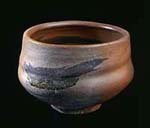 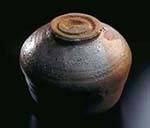
Yamase Chawan (Yamase Tea Bowl) 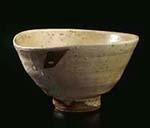 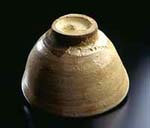
Chosen Karatsu Mimi-Tsuki Hana-Ire (Chosen- Karatsu Flower Vase with Handles) 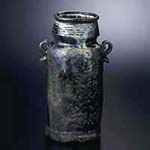
Madara Karatsu Tokkuri (Spotted Karatsu Sake Flask) 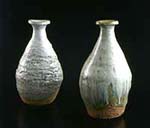
Karatsu Guinomi (Karatsu Sake Cup) 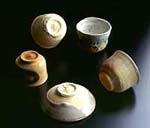
Karatsu Takahai (Karatsu Stemmed Cup) 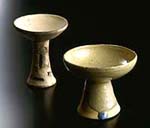
Karatsu Hira Hai (Karatsu Flat Sake Cup) 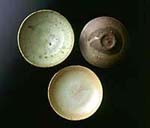
For information about Sajiro Tanaka's works... Namazu Net E-mail / namazudo@netlaputa.ne.jp Tel / 03-5468-8066 Fax / 03-5468-8067
|

At the Shibuya Kuroda Ceramics Exhibition The scroll in the tokonoma (alcove) was written by Mr. Tanaka |
 |